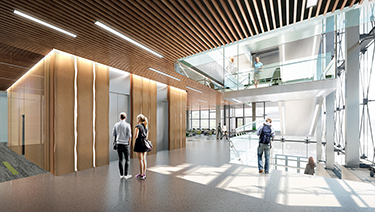|
Subscribe / Renew |
|
|
Contact Us |
|
| ► Subscribe to our Free Weekly Newsletter | |
| home | Welcome, sign in or click here to subscribe. | login |
Construction
| |
 |
November 16, 2017
9 Douglas firs will be installed as art in new Life Sciences Complex
Skanska USA

Guerrette
|
The University of Washington’s 210,000-square-foot Life Sciences Complex is on track to open next fall after a decade in the making.
Located on the south side of campus near Pacific Street, the seven-level structure (including two below ground) will serve over 1,500 biology students and faculty, offering undergraduate teaching labs and open, modular classrooms designed to adapt for collaboration and research needs.
Skanska USA started work on the project in spring 2016, and is now entering its fourth phase of construction: the interior build-out. Skanska crews, subcontractors and the design team from Perkins+Will are working to bring the university’s vision for the complex to life, including features that use natural materials and capture the spirit of the Pacific Northwest.
A tree installation
Wood is often the hallmark of regionally inspired interiors. However, Skanska, the design team and the university had a new idea for the harvested timber destined for this project.
“One of the biology professors, Dr. Scott Freeman, offered to donate trees from his property for use in the construction of the building,” said Kirk Brewer, a Skanska senior project manager.
“Since the elevator shaft runs the full height of the building, the team saw an interesting opportunity to include a lifelike tree installation to add to the unique look and purpose of the building.”
Freeman and his wife, Susan, led the design and construction team to Quilcene, a small Hood Canal-area community at the foot the Olympic Mountains. While it’s nationally known for its oysters, Quilcene is also home to Olympic National Forest lands full of Douglas firs. Timber and wood-product professionals from around the globe are familiar with this Northwest tree, second in height only to the redwood.
When selecting timber for use in building design, height is not typically a factor because the trees are cut into things like beams and planks. However, for the elevator feature, the Skanska team hand-selected nine Douglas firs they could envision reconstructed inside the new Life Sciences Complex. Each tree stood at least 150 feet tall.
The selected trees were harvested, then labeled for future assembly. In October, the cores were milled to project specifications.
Skanska plans to install the trees early next year, assembled from top to bottom as they stood in the forest.
How?
The labels placed at harvest allow the project team to line up individual pieces along the height of the elevator shaft. The core of each tree is then placed inside the building’s elevator lobby facade. The outer shells, which would otherwise be thrown away, will line the adjacent sides of the elevator core to depict the sides of each tree in the forest.
“This was great teamwork, but it really speaks to customer commitment,” Kirk said.
“There is no shortage of places that can source this wood. Instead, though, we’ve created something with someone who will work in the building, and help the staff connect with their new facility and feel a sense of ownership.”
Preserving cedars
In addition to the elevator feature, subcontractor Creoworks will use harvested alder trees to make furniture and other interior elements throughout the building.
Skanska also took measures to preserve the eight massive Deodar cedar trees standing on the north side of the project. Crews constructed a “bridge” from Stevens Way onto the jobsite, rerouting construction traffic and dodging compression of the trees’ roots. The bridge protected the trees from damage throughout construction of the building, and allowed Skanska to integrate the ancient giants into the building’s final design and end use.
The building will look as if it has been there for years — just like the wall of Deodars standing along its northern edge.
The new complex will also include a world-class greenhouse next to the Burke-Gilman Trail, planned to house over 3,000 plants species.
Skanska plans to wrap up construction in July 2018, just a few months prior to fall quarter.
Lew Guerrette is a project executive for Skanska USA with over 25 years of experience coordinating and delivering preconstruction and construction services.
Other Stories:
- Computer science building aims to be a home away from home
- Troy Hall rehab shows why universities like design-build
- WSU art museum a crimson ‘jewel box’ in the heart of campus
- Tacoma Paper & Stationery channels UWT’s urban vibe
- Designers use a prototype to keep UW dorm project on budget
- UW's utility plant is meant to be seen
- WSU: Top 10 capital projects
- UW: Top 10 capital projects
- WSU branch in Everett will prepare students for STEM careers



